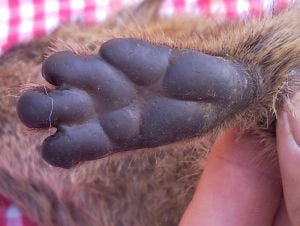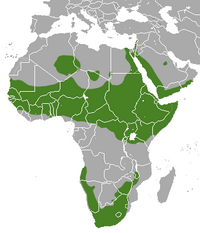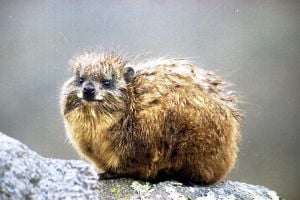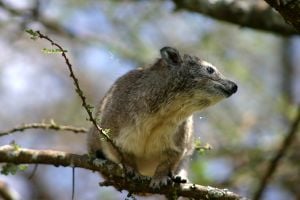Difference between revisions of "Hyrax" - New World Encyclopedia
Rick Swarts (talk | contribs) |
Rick Swarts (talk | contribs) |
||
| Line 22: | Line 22: | ||
| − | Four species are | + | Four species are recognized: the [[rock hyrax]] (''Procavia capensis''), the [[yellow-spotted rock hyrax|yellow-spotted rock hyrax]] (''Heterohyrax brucei''), the [[western tree hyrax|western tree hyrax]] (''Dendrohyrax dorsalis'') and the [[southern tree hyrax|southern tree hyrax]] (''Dendrohyrax arboreus''). |
==Physical description== | ==Physical description== | ||
| Line 60: | Line 60: | ||
==Classification== | ==Classification== | ||
| − | + | ==Extant species== | |
| + | Four extant species currently are recognized; the [[rock hyrax]] (''Procavia capensis''), the [[yellow-spotted rock hyrax|yellow-spotted rock hyrax]] (''Heterohyrax brucei''), the [[western tree hyrax|western tree hyrax]] (''Dendrohyrax dorsalis'') and the [[southern tree hyrax|southern tree hyrax]] (''Dendrohyrax arboreus''). | ||
| + | |||
| + | More species used to be recognized, but in the 2000s, taxonomists [[lumpers and splitters|reduced]] the number of recognized species of hyrax. In 1995, there were eleven or more recognized species; in 2013, only four are recognized. The animals which are no longer recognized as species are regarded as subspecies of the recognized four. There are over 50 recognized subspecies and species, many of which are considered highly endangered (Shoshani 2005). | ||
| + | |||
| + | * '''ORDER HYRACOIDEA''' | ||
| + | ** '''Family Procaviidae''' | ||
| + | *** Genus ''[[Dendrohyrax]]'' | ||
| + | **** [[Southern tree hyrax]], ''Dendrohyrax arboreus'' | ||
| + | **** [[Western tree hyrax]], ''Dendrohyrax dorsalis'' | ||
| + | *** Genus ''[[Heterohyrax]]'' | ||
| + | **** [[Yellow-spotted rock hyrax]], ''Heterohyrax brucei'' | ||
| + | *** Genus ''[[Procavia]]'' | ||
| + | **** [[Rock hyrax]], ''Procavia capensis'' | ||
| + | |||
| + | ===Extinct species=== | ||
| − | |||
*[[Pliohyracidae]] | *[[Pliohyracidae]] | ||
**''[[Geniohyinae]]'' | **''[[Geniohyinae]]'' | ||
| Line 93: | Line 107: | ||
****''[[Procavia transvaalensis]]'' | ****''[[Procavia transvaalensis]]'' | ||
| − | + | The [[extinct]] [[meridiungulata|meridiungulate]] [[Family (biology)|family]] '''[[Archaeohyracidae]]''', consisting of four [[genus|genera]] of [[Notoungulata|notoungulate]] [[mammal]]s known from the [[Paleocene]] through the [[Oligocene]] of [[South America]] (McKenna and Bell 1997) is a group unrelated to the true hyraxes. | |
| − | |||
| − | |||
| − | |||
| − | |||
| − | |||
| − | |||
| − | |||
| − | |||
| − | |||
| − | |||
| − | |||
| − | |||
==Evolution== | ==Evolution== | ||
| Line 133: | Line 135: | ||
<ref>{{cite journal |first=Hubert |last=Hendrichs |year=1966 |title=Vergleichende Untersuchung des Wiederkauverhaltens |trans_title=Comparative investigation of cud retainers |journal=Biologisches Zentralblatt |volume=84 |issue=6 |pages=671–751 |language=German |type=dissertation |oclc=251821046 |quote=All artiodactyl families and about 80% of the spp. were investigated. Chewing regurgitated fodder is an idle pastime as well as an instinct associated with appetite. Characteristic movements were analyzed for undisturbed samples of animals maintained on preserves. Group specific differences are reported in form, rhythm, frequency and side of chewing motion. The ungulate type is characterized as a specialization. The operation is described for the first time for the order Hyracoidea. On the basis of 12 spp. of the marsupial subfamily Macropodinae rumination is inferred for the whole category. Advantages of the process are debated}}{{Verify source|Where did the quote come frome? The article is in German. Who translated?|date=February 2011}}</ref> | <ref>{{cite journal |first=Hubert |last=Hendrichs |year=1966 |title=Vergleichende Untersuchung des Wiederkauverhaltens |trans_title=Comparative investigation of cud retainers |journal=Biologisches Zentralblatt |volume=84 |issue=6 |pages=671–751 |language=German |type=dissertation |oclc=251821046 |quote=All artiodactyl families and about 80% of the spp. were investigated. Chewing regurgitated fodder is an idle pastime as well as an instinct associated with appetite. Characteristic movements were analyzed for undisturbed samples of animals maintained on preserves. Group specific differences are reported in form, rhythm, frequency and side of chewing motion. The ungulate type is characterized as a specialization. The operation is described for the first time for the order Hyracoidea. On the basis of 12 spp. of the marsupial subfamily Macropodinae rumination is inferred for the whole category. Advantages of the process are debated}}{{Verify source|Where did the quote come frome? The article is in German. Who translated?|date=February 2011}}</ref> | ||
| + | |||
| + | <ref>McKenna, Malcolm C., and Bell, Susan K. 1997. ''Classification of Mammals Above the Species Level.'' Columbia University Press, New York, 631 pp. ISBN 0-231-11013-8</ref> | ||
<ref>JB Sale - JE Afr. Nat. Hist. Soc, 1966</ref> | <ref>JB Sale - JE Afr. Nat. Hist. Soc, 1966</ref> | ||
| + | |||
| + | Shoshani, J. (2005). Wilson, D. E.; Reeder, D. M, eds. Mammal Species of the World (3rd ed.). Johns Hopkins University Press. pp. 87–89. ISBN 978-0-8018-8221-0. OCLC 62265494. | ||
<ref name=EoM>{{cite book |editor=Macdonald, D. |author=Hoeck, Hendrik |year=1984 |title=The Encyclopedia of Mammals |publisher=Facts on File |location=New York |pages=462–5 |isbn=0-87196-871-1}}</ref> | <ref name=EoM>{{cite book |editor=Macdonald, D. |author=Hoeck, Hendrik |year=1984 |title=The Encyclopedia of Mammals |publisher=Facts on File |location=New York |pages=462–5 |isbn=0-87196-871-1}}</ref> | ||
Revision as of 23:49, 30 January 2014
| Hyraxes
|
|---|
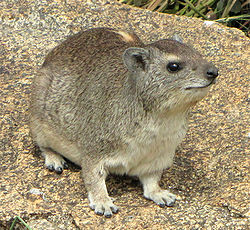 Yellow-spotted hyrax (Heterohyrax brucei)
|
| Scientific classification |
|
|
|
Hyrax is the common name for any of the small, largely herbivorous mammals comprising the order Hyracoidea and characterized by thickset bodies, short tails, and three-toed hind feet with rounded, hoof-like nails on two of the toes and a claw on the third. These mammals, which can be described as having a guinea pig or woodchuck-like body, and are similar in size to a large rabbit, are also known as cories and dassies. The presence of specialized muscles in the soles of the feet, combined with the soft and elastic nature of the sweat-gland moistened soles, helps to create a suction-like friction with rocks and other substrate. Hyraxes are often mistaken for rodents, but are more closely related to elephants. There is one extant family of hyraxes, Procaviidae, distributed only in Africa and the Middle East.
values food chain and to humans
Four species are recognized: the rock hyrax (Procavia capensis), the yellow-spotted rock hyrax (Heterohyrax brucei), the western tree hyrax (Dendrohyrax dorsalis) and the southern tree hyrax (Dendrohyrax arboreus).
Physical description
Hyraxes are well-furred, shot-tailed, rotund animals about the size of a large rabbit. Typically, they measure between 30 and 70 centimeters (12-28 inches) long and weigh between 2 and 5 kilograms (4-11 pounds).
Hyraxes have 3-toed hind feet with two of the toes with rounded nails that resemble hooves, while the inner toe has a claw. Forefeet generally have four or five toes. The soles of their fore- and hindfeet are soft, elastic, rubbery like pads, moistened by numerous specialized sweat glands, which increases friction and help the animal maintain its grip when quickly moving up steep, rocky surfaces. The soles of the feet also have specialized muscles in this regard, which helps the soles to work somewhat like suction cups. The plane of symmetry of the feet goes through the third digit (Myers 2000).
Hyraxes have skulls with a short rostrum and prominent postorbital processes. They have a single incisor on each side of the upper jaw and two on the lower. Like rodents, the incisors grow continuously throughout life, and the presence of enamel on only one side (the anterior surface) creates a self-sharpening cutting edge. The molars have strongly developed lophs. Unlike most other browsing and grazing animals, they do not use the incisors at the front of the jaw for slicing off leaves and grass, rather, they use the molar teeth at the side of the jaw. There is a small diastema between the incisors and the cheek teeth. The dental formula for hyraxes is (Myers 2000).
Although not ruminants, hyraxes have complex, multi-chambered stomachs that allow symbiotic bacteria to break down tough plant materials; their overall ability to digest fibers is similar to that of the ungulates (von Engelhardt et al. 1978). Their mandibular motions have often been described as chewing cud (Hendrichs 1966), although there is no evidence this behavior is associated with the regurgitation of stomach contents (Sale 1966) as in the even-toed ungulates and some of the macropods. This behavior is referred to in a passage in the Bible (Leviticus 11:5), which describes hyraxes as chewing the cud. Hyraxes also have efficient kidneys, retaining water so that they can better survive in arid environments.
Hyraxes retain a number of primitive mammalian characteristics; in particular, they have poorly developed internal temperature regulation, which they compensate for by behavioural thermoregulation such as huddling and by basking in the sun.
Distribution and habitat
Hyraxes inhabit rocky terrain, forests, and moist savannah across sub-Saharan Africa and the Middle East. The rock hyrax (Procavia capensis) occurs across sub-Saharan Africa, with the exception of the Congo basin and Madagascar. The western tree hyrax (Dendrohyrax dorsalis), is found in West and Central Africa: Benin, Cameroon, Central African Republic, Republic of the Congo, Democratic Republic of the Congo, Ivory Coast, Equatorial Guinea, Gabon, Gambia, Ghana, Guinea, Guinea-Bissau, Liberia, Nigeria, Rwanda, Senegal, Sierra Leone, Sudan, Togo, Uganda, and possibly Niger. The southern tree hyrax (Dendrohyrax arboreus) is found in Angola, Democratic Republic of the Congo, Kenya, Mozambique, South Africa, Tanzania, and Zimbabwe. Heterohyrax brucei, the yellow-spotted rock hyrax or bush hyrax, is found in Angola, Botswana, Burundi, Democratic Republic of the Congo, Southern Egypt, Eritrea, Ethiopia, Kenya, Malawi, Mozambique, Rwanda, Somalia, Northern South Africa, Sudan, Tanzania, Uganda, Zambia, and Zimbabwe.
Some species are arboreal (the western tree hyrax and southern tree hyrax) and some live on rock outcrops (rock hyrax and yellow-spotted rock hyrax).
Behavior
Hyraxes are agile climbers and quick, and active during the daylight hours. Arboreal hyraxes tend to be solitary while those dwelling in rock outcrops tend to live in colonies (Myers 2000).
Female hyraxes give birth to up to four young after a gestation period of between seven and eight months, depending on the species. The young are weaned at one to five months of age, and reach sexual maturity at 16 to 17 months.
Hyraxes living in small family groups are dominated by a single male, who aggressively defends the territory from rivals. Where there is abundant living space, the male may dominate multiple groups of females, each with their own range. The remaining males live solitary lives, often on the periphery of areas controlled by larger males, and mate only with younger females (Hoeck 1984).
Historical accounts
The words "rabbit," "hare," or "coney" appear as terms for the hyrax in some English translations of the Bible. Early English translators had no knowledge of the hyrax (Hebrew שָּׁפָן shaphan),and therefore no name for them. There are references to hyraxes in the Old Testament (Lev 11:4-8; Deut 14:7; Ps 104:18; Prov 30:26) and notably Leviticus 11 in which they are described as lacking a split hoof and therefore being not kosher. It also incorrectly claims that the hyrax chews its cud. Some of the modern translations refer to them as rock badgers. .
Phoenician sailors visiting the coast of Spain circa 1100s B.C.E., mistaking the European rabbit for the rock hyrax from their native homeland, gave it the name i-shepan-ham. A theory exists that an adaptation and/or corruption of this name, used by the Romans, became Hispania, leading to Spanish España and English Spain, although this theory is somewhat controversial.
Classification
Extant species
Four extant species currently are recognized; the rock hyrax (Procavia capensis), the yellow-spotted rock hyrax (Heterohyrax brucei), the western tree hyrax (Dendrohyrax dorsalis) and the southern tree hyrax (Dendrohyrax arboreus).
More species used to be recognized, but in the 2000s, taxonomists reduced the number of recognized species of hyrax. In 1995, there were eleven or more recognized species; in 2013, only four are recognized. The animals which are no longer recognized as species are regarded as subspecies of the recognized four. There are over 50 recognized subspecies and species, many of which are considered highly endangered (Shoshani 2005).
- ORDER HYRACOIDEA
- Family Procaviidae
- Genus Dendrohyrax
- Southern tree hyrax, Dendrohyrax arboreus
- Western tree hyrax, Dendrohyrax dorsalis
- Genus Heterohyrax
- Yellow-spotted rock hyrax, Heterohyrax brucei
- Genus Procavia
- Rock hyrax, Procavia capensis
- Genus Dendrohyrax
- Family Procaviidae
Extinct species
- Pliohyracidae
- Geniohyinae
- Seggeurius
- Geniohyus
- Saghatheriinae
- Microhyrax
- Meroehyrax
- Selenohyrax
- Bunohyrax
- Pachyhyrax
- Megalohyrax
- Saghatherium
- Thyrohyrax
- Titanohyracinae
- Antilohyrax
- Titanohyrax
- Pliohyracinae
- Sogdohyrax
- Kvabebihyrax
- Prohyrax
- Parapliohyrax
- Pliohyrax
- Postschizotherium
- Geniohyinae
- Procaviidae
- Procaviinae
- Gigantohyrax
- Procavia (Rock hyrax)
- Procavia antigua
- Procavia transvaalensis
- Procaviinae
The extinct meridiungulate family Archaeohyracidae, consisting of four genera of notoungulate mammals known from the Paleocene through the Oligocene of South America (McKenna and Bell 1997) is a group unrelated to the true hyraxes.
Evolution
All modern hyraxes are members of the family Procaviidae (the only living family within the Hyracoidea) and are found only in Africa and the Middle East. In the past, however, hyraxes were more diverse, and widespread. The order first appears in the fossil record at a site in the Middle East in the form of Dimaitherium, 37 million years ago.[1] For many millions of years, hyraxes were the primary terrestrial herbivore in Africa, just as odd-toed ungulates were in North America. Through the middle to late Eocene, there were many different species,[2] the largest of them weighing the same as a small horse and the smallest the size of a mouse. During the Miocene, however, competition from the newly developed bovids, which were very efficient grazers and browsers, displaced the hyraxes out of the prime territory and into marginal niches. Nevertheless, the order remained widespread, diverse and successful as late as the end of the Pliocene (about two million years ago) with representatives throughout most of Africa, Europe and Asia.
The descendants of the giant hyracoids evolved in different ways. Some became smaller, and evolved to become the modern hyrax family. Others appear to have taken to the water (perhaps like the modern capybara), ultimately giving rise to the elephant family and perhaps also the sirenians. DNA evidence supports this hypothesis, and the small modern hyraxes share numerous features with elephants, such as toenails, excellent hearing, sensitive pads on their feet, small tusks, good memory, higher brain functions compared to other similar mammals, and the shape of some of their bones.[3]
Hyraxes are sometimes described as being the closest living relative to the elephant,[4] although whether this is so is disputed. Recent morphological and molecular-based classifications reveal the sirenians to be the closest living relatives of elephants. While hyraxes are closely related, they form a taxonomic outgroup to the assemblage of elephants, sirenians, and extinct orders such as Embrithopoda and Desmostylia.[5]
Similarities with elephants and sirenia
Hyraxes share several unusual characteristics with elephants and sirenia (manatees and dugongs) which have resulted in them all being placed in the taxon Paenungulata. Male hyraxes lack a scrotum and their testicles remain tucked up in their abdominal cavity next to the kidneys;[6][7] the same as elephants, manatees, and dugongs.[8] Female hyraxes have a pair of teats near their arm pits (axilla), as well as four teats in their groin (inguinal area); elephants have a pair of teats near their axillae, and dugongs and manatees have a pair of teats, one located close to each of the front flippers. The tusks of hyraxes develop from the incisor teeth as do the tusks of elephants; in most other mammals, tusks develop from the canines. Hyraxes, like elephants, have flattened nails on the tips of their digits, rather than curved, elongated claws which are usually seen on mammals (see[9]).
Hyraxes have highly charged myoglobin, which has been inferred to reflect an aquatic ancestry.[10]
ReferencesISBN links support NWE through referral fees
- ↑ Eugenie Barrow; Erik R. Seiffert; Elwyn L. Simons. (2010). A primitive hyracoid (Mammalia, Paenungulata) from the early Priabonian (Late Eocene) of Egypt. Journal of Systematic Palaeontology 8 (2): 213–244.
- ↑ Prothero, Donald R. (2006). After the Dinosaurs: The Age of Mammals. Bloomington, Indiana: Indiana University Press, 132. ISBN 978-0-253-34733-6.
- ↑ "Hyrax: The Little Brother of the Elephant", Wildlife on One, BBC TV.
- ↑ Hirax song is a menu for mating. The Economist (15 January 2009). Retrieved 15 January 2009.
- ↑ Asher, R.J., Novacek, M.J., Geisher, J.H. (2003). Relationships of endemic African mammals and their fossil relatives based on morphological and molecular evidence. J. Mamm. Evol. 10: 131–194.
- ↑ Trevor Carnaby (1 January 2008). Beat about the Bush: Mammals. Jacana Media. ISBN 978-1-77009-240-2.
- ↑ Septimus Sisson (1914). The anatomy of the domestic animals. W.B. Saunders Company.
- ↑ Marshall Cavendish Corporation (1 September 2010). Mammal Anatomy: An Illustrated Guide. Marshall Cavendish. ISBN 978-0-7614-7882-9.
- ↑ Picture of hyrax feet
- ↑ One Protein Shows Elephants and Moles Had Aquatic Ancestors.
Shoshani, J. (2005). Wilson, D. E.; Reeder, D. M, eds. Mammal Species of the World (3rd ed.). Johns Hopkins University Press. pp. 87–89. ISBN 978-0-8018-8221-0. OCLC 62265494.
- Myers, P. 2000. Hyracoidea. Animal Diversity Web. Retrieved January 30, 2014.
| Mammals |
|---|
| Monotremata (platypus, echidnas) |
|
Marsupialia: | Paucituberculata (shrew opossums) | Didelphimorphia (opossums) | Microbiotheria | Notoryctemorphia (marsupial moles) | Dasyuromorphia (quolls and dunnarts) | Peramelemorphia (bilbies, bandicoots) | Diprotodontia (kangaroos and relatives) |
|
Placentalia: Cingulata (armadillos) | Pilosa (anteaters, sloths) | Afrosoricida (tenrecs, golden moles) | Macroscelidea (elephant shrews) | Tubulidentata (aardvark) | Hyracoidea (hyraxes) | Proboscidea (elephants) | Sirenia (dugongs, manatees) | Soricomorpha (shrews, moles) | Erinaceomorpha (hedgehogs and relatives) Chiroptera (bats) | Pholidota (pangolins)| Carnivora | Perissodactyla (odd-toed ungulates) | Artiodactyla (even-toed ungulates) | Cetacea (whales, dolphins) | Rodentia (rodents) | Lagomorpha (rabbits and relatives) | Scandentia (treeshrews) | Dermoptera (colugos) | Primates | |
Template:Hyracoidea
Credits
New World Encyclopedia writers and editors rewrote and completed the Wikipedia article in accordance with New World Encyclopedia standards. This article abides by terms of the Creative Commons CC-by-sa 3.0 License (CC-by-sa), which may be used and disseminated with proper attribution. Credit is due under the terms of this license that can reference both the New World Encyclopedia contributors and the selfless volunteer contributors of the Wikimedia Foundation. To cite this article click here for a list of acceptable citing formats.The history of earlier contributions by wikipedians is accessible to researchers here:
The history of this article since it was imported to New World Encyclopedia:
Note: Some restrictions may apply to use of individual images which are separately licensed.
- ↑ Hendrichs, Hubert (1966). Vergleichende Untersuchung des Wiederkauverhaltens. Biologisches Zentralblatt 84 (6): 671–751.[verification needed]
- ↑ McKenna, Malcolm C., and Bell, Susan K. 1997. Classification of Mammals Above the Species Level. Columbia University Press, New York, 631 pp. ISBN 0-231-11013-8
- ↑ JB Sale - JE Afr. Nat. Hist. Soc, 1966
- ↑ Hoeck, Hendrik (1984). in Macdonald, D.: The Encyclopedia of Mammals. New York: Facts on File, 462–5. ISBN 0-87196-871-1.
- ↑ von Engelhardt et al. (1978) Production of methane in two non-ruminant herbivores. Comparative Biochemistry and Physiology Part A: Physiology 60 (3) 309-311
